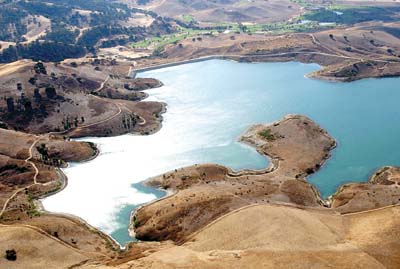
More than five years after its closure, it doesn’t look like San Justo Reservoir will be open anytime soon, according to San Benito County officials.
At the San Benito County Board of Supervisors meeting Tuesday, Dale Rosskamp, the deputy district manager for the San Benito County Water District, updated officials on the half-decade long process to remove the non-native zebra mussels that threaten the reservoir, telling the board that the plan could take another three to five years to implement.
Still, “it was encouraging” to get the update, said Supervisor Robert Rivas in a phone interview. “Up until yesterday’s update, it sounded like eradicating the mussel was nearly impossible.”
Other priorities at the U.S. Bureau of Reclamation office in Fresno have consumed the government agency, putting the plan – known as the Zebra Mussel Eradication Project – on hold.
“We’ve done as much as we can,” Rosskamp said.
Last June, the county approved and finalized the state environmental review of the project. However, the process of obtaining a federal environmental approval has been shelved “pending resolution of higher priority projects.” In order to obtain the funds to complete the project, the Bureau of Reclamation, which is overseeing the environmental process and also owns the reservoir, must submit a federal budget allocation request to Congress. But before the budget process can go forward, said county officials, the environmental process has to be completed.
“They (Bureau of Reclamation) have nothing in their budget” for this project, said Rosskamp.
The fingernail-sized mussels were discovered at the popular fishing and recreational spot in January 2008. Although other mussels such as quagga mussels in the East Bay have caused problems there, San Justo Reservoir is the only known place the zebra mussel resides on the West Coast.
The mussels populate quickly and can clog delivery systems. The reservoir was shut down promptly after the discovery.
“The mussels can cause a lot of problems,” said Ray Espinosa, the interim county administration officer.
The plan, called the Zebra Mussel Eradication Project, would use “potash,” or naturally-occurring potassium chloride, to effectively suffocate the mussels and kill them off. The project would cost the state and county about $2.5 million to complete.
Even if the project gets a green light tomorrow, said Rosskamp, it would take a year to fully eradicate the mussels and another two to monitor the reservoir to make sure the mussels have not returned.
“It’s going to take time and resources,” Rivas said. Still, he said, among county budget concerns and limited resources, the clean-up “doesn’t seem really realistic” at this time.
In the meantime, the water district continues to monitor the mussels and uses a process of desiccation to dry out the reservoir to deprive the mussels of water, as well as a process of depriving the mussels of oxygen.
“We’ve been able to hold down (their numbers) homeopathically,” Rosskamp said.






